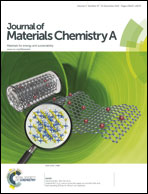Ultra-light 3D nanofibre-nets binary structured nylon 6–polyacrylonitrile membranes for efficient filtration of fine particulate matter†
Abstract
Particulate matter (PM) with an aerodynamic diameter of 2.5 micrometers or less (PM2.5), as one of the most hazardous air pollutants, has raised serious concerns for public health. Although individual or environmental protection could be achieved using conventional fibrous media, high performance filters usually rely on energy-intensive and bulky air-filtering media. In this work, an ultra-lightweight nylon 6–polyacrylonitrile nanofibre-nets binary (N6–PAN NNB) structured membrane, consisting of an ambigenous nanofibre framework through which run two-dimensional nano-nets, for sieving-enhanced capture of fine particles was demonstrated. The high coverage N6 nano-nets and low packing density of PAN nanofibres are certified as an efficient property promoter when the fibre spinning jet ratio of N6/PAN reaches 2/2, thereby improving the porosity, filtration efficiency, flow resistance, and stability. Upon exposure to 300 nm NaCl aerosol particles, the N6–PAN2/2 NNB membrane with a low basis weight of 2.94 g m−2 exhibited high filtration efficiency (99.99%) and desirable quality factor (0.1163 Pa−1) even though under a high flow rate (90 L min−1), significantly better results than those of glass fibre and melt-blown polypropylene fibre-based media. Ultimately, three-dimensional computer simulation based on the images of N6-15 and N6–PAN2/2 membranes after particle loading and filtration data via GeoDict were processed statistically through principal component analysis and then used to graphically express the particle deposition pattern change from surface filtration to deep bed filtration. We hope that the methodology and results presented here will encourage different approaches to diminish the negative impact of PM2.5 air pollution, in particular the frequency of haze occurrence in rapidly developing countries.


 Please wait while we load your content...
Please wait while we load your content...